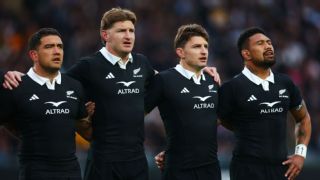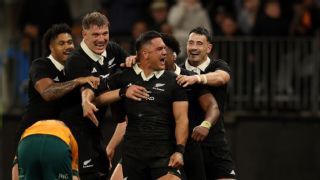|
The All Blacks completed their turbulent Rugby Championship campaign with back-to-back victories over the Wallabies to signal they are, perhaps, improving. Their latest win in Perth was achieved without incumbents Beauden Barrett, Caleb Clarke, Tupou Vaa'i, Tyrel Lomax and Ethan de Groot to expose others and offer alternative answers in some areas. Further evidence, though, is required before anyone could suggest the All Blacks are back. Resurgent is certainly a gross overstatement at this point. As they refresh and reset before trekking north for their four-match grand slam tour that starts against Ireland in Chicago in early November, let's assess where Scott Robertson's team are placed. Team dynamic:Losing the Rugby Championship title -- albeit on points differential -- to the Springboks for a second successive year is a definitive indication that the southern hemisphere balance of power has shifted. While the All Blacks retained the Bledisloe Cup, they paid the price for their heaviest defeat in history against the Springboks in Wellington and their maiden loss in Argentina. Both are unwanted records. From a team perspective, the All Blacks are developing depth at prop and loose forward as Robertson pushes ahead with his quest to have four deep in each position. Robertson has already used 43 players this year after ushering in another nine rookies to the Test scene. The intention to blood talent is clear but the likes of Ruben Love, the All Blacks' third choice No 10, is yet to gain any experience as a Test playmaker. Gauging the All Blacks' progress is difficult at this juncture as their inconsistencies prior to confronting the Wallabies leave a sense of vulnerability hanging in the air. Have they turned a corner or was the Bledisloe a mere mirage? The All Blacks scrum improved against the Wallabies but they face much tougher tests in that area. The lineout has been their best strike platform, providing 14 tries in the tournament, only to falter at other times.  The breakdown, where Wallabies flanker Fraser McReight and his counterparts enjoyed success, is another concern and the All Blacks are not out of the woods with their work under the high ball, either. Defensively the All Blacks were exposed in this tournament on the edge and through the middle but their second half in Perth, as the rain streamed down, set the standard for the remainder of the year. Their attack that struggled to fire improved in the last two wins to offer promise that better fluency and execution is on the horizon. A 7 from 9 return thus far this year suggests the All Blacks are on the rise -- yet that record is deceiving after France sent a decidedly second-string team to New Zealand for their predictable 0-3 tour in July. "Throughout this Rugby Championship we've learnt we need to front up every week when you put the All Blacks jersey on. A couple of times we clearly didn't do that. Those are tough lessons. This group has a few scars from that," All Blacks captain Scott Barrett said. "We want to have a refresh before we head up north and chase a grand slam." Squad shape:Losing starting tighthead prop Tyrel Lomax and lock/loose forward Tupou Vaa'i are significant blows to the All Blacks forward pack. Vaa'i was among the best performers from lock last year and the All Blacks will miss his versatility after he started the first three Tests this season from blindside. Beauden Barrett, Clarke and de Groot will return for the northern tour but wing Emoni Narawa and halfback Noah Hotham, both of whom suffered season-ending injuries, must also be replaced in the 36-man squad that will be named earlier next week. Big movers:Leroy Carter: The sevens convert is proving the All Blacks waited too long to inject him this year. Carter, alongside Narawa, was the best winger in his rookie Super Rugby Pacific season with the Chiefs. He's now scored three tries in as many tests after debuting against the Springboks in Wellington to cement his presence on the edge for the All Blacks. Defensively Carter punches above his weight -- look no further than two big shots on the vaunted Wallabies midfield at Eden Park -- and he constantly goes looking for work. Quinn Tupaea: Hadn't started at centre for five years at the Chiefs before being thrust into the No. 13 jersey in Perth -- and yet immediately seemed at home. Tupaea delivered a breakout performance that featured two tries and two try assists against the Wallabies. The All Blacks rewarded his physical, direct presence off the bench -- and it paid off. Defensively, Tupaea handled the difficult shift, too, by cutting down Max Jorgensen on the outside which is no easy feat. It will be difficult to leave him out of the next assignment after that statement.  Leicester Faingaʻanuku: Two years, 721 days, after his last appearance for the All Blacks, Faingaʻanuku reminded everyone he's lost none of his destructive ball carrying prowess. Wing is unlikely to be his future, particularly when Clarke returns to the left edge, but he will be a weapon the All Blacks can unleash from the bench or in the midfield. Peter Lakai: Seized his first Test start at No. 8 to give Robertson plenty to ponder around his loose forward trio. Lakai's point of difference is his dynamic ball carrying. And with Wallace Sititi yet to hit the heights of last year after his return from multiple injury layoffs, Lakai is a strong contender to retain the starting duties. With the ability to play seven and six too, the 22-year-old Lakai joins Sititi as the future of the All Blacks loose forwards. Under threat:Rieko Ioane: Back-to-the-future shift from centre to wing didn't work out. Billy Proctor has started seven of nine tests at centre this year and with Tupaea and Faingaʻanuku pushing hard for that role too, Ioane is in danger of being squeezed out. Versatility will keep Ioane in contention for the bench but, come the end of the year, his six month stint at Leinster could make or break his future. Anton Lienert-Brown: Another midfielder seemingly on the outer. The ability to play both midfield positions has long marked Lienert-Brown as an ideal bench option but with the All Blacks seeking more punchy impact, he now needs injuries to get a look in. Luke Jacobson: The stacked loose forwards have confined Chiefs captain Jacobson to the fringe. Injury robbed him of an appearance against France in Hamilton but he's yet to feature for the All Blacks this year. And with the desire to harness big ball carriers from six and eight, it's hard to see that changing anytime soon. Sevu Reece: Time appears to be almost up on the 28-year-old's Test career. Robertson maintained faith for an extended period but with his pace dwindling, Carter emerging, and others knocking down the door, Reece could soon find he is surplus to requirements. Brodie McAlister: Third choice hooker is under pressure to maintain his place after some horror lineout throwing, with Hurricanes counterpart Asafo Aumua offering much more upside. Best performers:Jordie Barrett: Consistently underrated presence. Sparked the All Blacks in Perth with two grubber kicks and increasingly used in the back field to defuse the deluge of high balls the All Blacks are pelted with. Several try-saving tackles in this tournament too. Ardie Savea: Played every minute of every test this year -- and 19 straight games for the All Blacks without being replaced. It's easy to see why. The captaincy elevates Savea to another level -- as was evident for Moana Pasifika and in the fortress-preserving victory against the Springboks at Eden Park. When Scott Barrett is fit, though, Savea will revert to inspirational deputy duties. Cam Roigard, Codie Taylor, Caleb Clarke: Instrumental in their respective influence when fit. Roigard with his running threat and kicking game. Taylor by steadying the set piece. And Clarke with his power carries and under the high ball.
|
